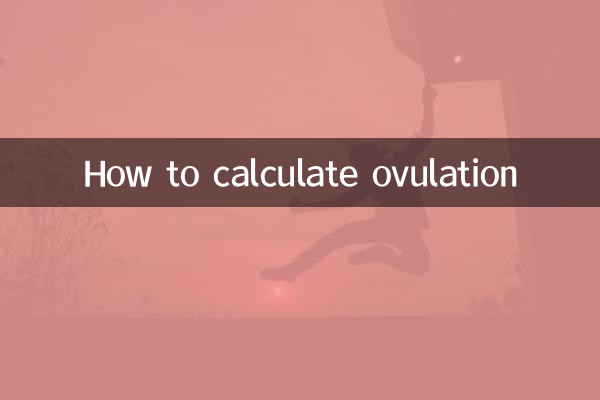How to calculate ovulation
Ovulation is an important stage in a woman's reproductive cycle. Accurately calculating the ovulation period can not only help women who are preparing for pregnancy increase their chances of conception, but also provide a reference for contraception. This article will combine the hot topics and hot content on the Internet in the past 10 days to introduce you in detail how to calculate the ovulation period, and provide structured data for a more intuitive understanding.
1. What is ovulation?

Ovulation is the time when a woman's ovaries release mature eggs, usually in the middle of the menstrual cycle. Eggs survive in the fallopian tube for about 12-24 hours, while sperm can survive in the female body for 2-3 days, so the days before and after ovulation are the peak period for conception.
2. Calculation method of ovulation period
Here are a few common ways to calculate ovulation:
| method | Description | Advantages | Disadvantages |
|---|---|---|---|
| calendar method | Calculate ovulation day based on menstrual cycle (14 days before next menstruation) | Simple and easy | Not suitable for women with irregular menstruation |
| basal body temperature method | Take your temperature every morning. After ovulation, your body temperature will rise by 0.3-0.5°C. | Data is objective | Requires long-term measurement |
| cervical mucus observation method | Cervical mucus becomes clearer and more elastic during ovulation | No tools required | Requires certain experience to judge |
| Ovulation test paper method | Detection of peak levels of luteinizing hormone (LH) in urine | High accuracy | Need to buy test strips |
3. Symptoms during ovulation
In addition to determining the ovulation period through calculation methods, the female body will also have some obvious symptoms:
| Symptoms | Appearance time | duration |
|---|---|---|
| Mild pain in lower abdomen | 1-2 days before ovulation | a few hours to 2 days |
| breast tenderness | after ovulation | 3-5 days |
| Increased libido | 1-2 days before ovulation | 2-3 days |
| Increased basal body temperature | after ovulation | Continue until next menstruation |
4. Factors affecting the accuracy of ovulation period
Many factors can affect the accuracy of ovulation, and understanding these factors can help you calculate more accurately:
1.stress factors: Long-term mental stress may delay ovulation
2.disease factors: Diseases such as polycystic ovary syndrome can affect ovulation
3.drug factors: Certain medications such as antibiotics may interfere with ovulation
4.age factor: Ovulation may become irregular after age 35
5.living habits: Excessive dieting or strenuous exercise may inhibit ovulation
5. Suggestions for improving the accuracy of ovulation calculation
1.Use a combination of methods: Combined with calendar method, body temperature method and ovulation test paper method
2.Keep records: Establish a menstrual cycle record sheet to record at least 3 months of cycles
3.Use technology to assist: Download the professional ovulation period calculation APP
4.Consult a specialist: If you have any questions or irregular menstruation, it is recommended to seek medical consultation.
5.maintain a healthy lifestyle: Regular work and rest, balanced diet, moderate exercise
6. Ovulation period calculation example
Here is an example of ovulation calculation for a standard 28-day menstrual cycle:
| menstrual cycle days | stage | Description |
|---|---|---|
| 1-5 days | menstrual period | Endometrial shedding |
| 6-13 days | follicular phase | follicles mature |
| 14 days | Ovulation day | Egg discharge |
| 15-28 days | Luteal phase | Preparing for conception |
For women with irregular menstrual cycles, it is recommended to first record the cycle length for several months, find out the shortest and longest cycles, and then subtract 18 days from the shortest cycle as the first day of ovulation, and subtract 11 days from the longest cycle as the last day of ovulation.
Conclusion
Accurately calculating ovulation is crucial for pregnancy preparation or contraception. Through the methods and structured data introduced in this article, I hope it can help you understand your fertility cycle more scientifically. Remember, every woman’s body is different, and it’s most important to find the calculation method that works best for you.

check the details

check the details